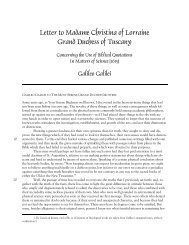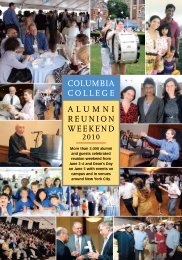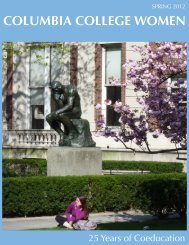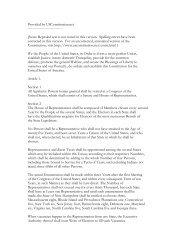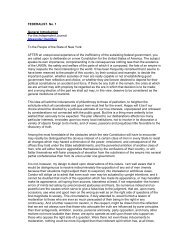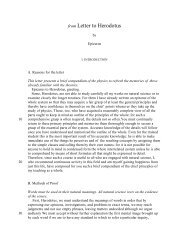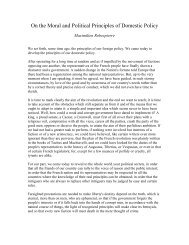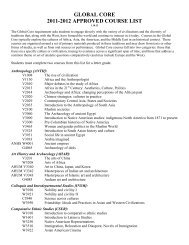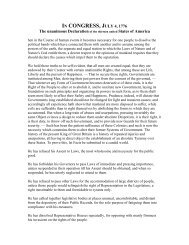Download this issue as a PDF - Columbia College - Columbia ...
Download this issue as a PDF - Columbia College - Columbia ...
Download this issue as a PDF - Columbia College - Columbia ...
Create successful ePaper yourself
Turn your PDF publications into a flip-book with our unique Google optimized e-Paper software.
COLUMBIA COLLEGE TODAY<br />
Vision Quest<br />
Through decades of research, Dr. George Yancopoulos ’80 oversees numerous<br />
drug advances — including a breakthrough in one to treat eye dise<strong>as</strong>e<br />
B y Dav i d McKay W i l s o n<br />
Dr. George Yancopoulos ’80, ’86 GSAS, ’87<br />
P&S seemed to have it all in spring 1987.<br />
With his newly minted doctorate in<br />
biochemistry and molecular biophysics<br />
in hand, he’d accepted a faculty post at<br />
P&S and had won a coveted $2 million<br />
award from the Lucille P. Markey Charitable<br />
Trust to support his research across<br />
eight years.<br />
But the <strong>Columbia</strong> research labs had yet to be built and the<br />
timetable for their completion kept shifting. Through research circles<br />
in biotechnology’s early days, he’d met Dr. Leonard Schleif er,<br />
an enterprising neurologist intent on using gene technology to<br />
regenerate neurons — the impulse-conducting cells that serve<br />
<strong>as</strong> the functional unit of the nervous system.<br />
The company w<strong>as</strong> named Regeneron, and Schleifer wanted<br />
Yancopoulos to be its founding scientist.<br />
“Len w<strong>as</strong> a very ambitious, big-thinking kind of guy who w<strong>as</strong><br />
charismatic, honest and genuine,” says Yancopoulos, who received<br />
a 2013 John Jay Award for distinguished professional achievement<br />
from the <strong>College</strong> in March. “We really hit it off.”<br />
At the time Schleifer approached him, Yancopoulos, the son<br />
of Greek immigrants, w<strong>as</strong> hearing little cheering around the Sunday<br />
dinner table in Queens about his career in academic scientific<br />
research. His father, Damis George Yancopoulos, who patched together<br />
a living at jobs that ranged from furrier to insurance salesman,<br />
reminded his son that the grant covered the laboratory’s<br />
equipment <strong>as</strong> well, leaving him with a relatively modest salary.<br />
“I thought I’d hit the big time,” says Yancopoulos of his academic<br />
prospects. “I thought my father would finally be proud of me.”<br />
His father, however, had a different path in mind for his firstborn<br />
son and namesake, the valedictorian at Bronx Science <strong>as</strong><br />
well <strong>as</strong> the <strong>College</strong>. Perhaps it w<strong>as</strong> in the private sector, putting<br />
his scientific talents to use healing patients, one at a time, <strong>as</strong> a<br />
physician. Or he could continue his research in a corporate pharmaceutical<br />
lab, discovering drugs that would alleviate human<br />
suffering for millions. His son might even earn a fortune.<br />
George’s father w<strong>as</strong> always talking up Dr. P. Roy Vagelos ’54<br />
P&S, also the son of Greek immigrants, who vaulted from academic<br />
research to chief scientific officer of Merck & Co., and later w<strong>as</strong><br />
the Big Pharma giant’s CEO. He’d often clip articles about Vagelos<br />
from Greek newspapers to send his son, detailing how Greece w<strong>as</strong><br />
proud that the Merck executive had made it big, very big.<br />
“My dad knew scientists didn’t make much money, and he<br />
wanted to educate his son to make money,” says Yancopoulos.<br />
“He’d read about Roy Vagelos, and he told me, ‘Why don’t you<br />
be like Roy Vagelos’ When I hit a rough spot in grad school, he<br />
told me, ‘Just call Roy Vagelos, he’ll help you out.’”<br />
Yancopolous never called Vagelos. But his father’s advice w<strong>as</strong><br />
present in his mind following his meetings with Schleifer, <strong>as</strong> he designed<br />
his post-doctoral life. It w<strong>as</strong> settled. He turned down the $2<br />
million Markey award. He turned down the <strong>Columbia</strong> faculty position.<br />
And he joined Schleifer <strong>as</strong> Regeneron’s founding scientist.<br />
“I gave up eight years of guaranteed funding for a company<br />
that at the time w<strong>as</strong> located in Len’s apartment on the Upper E<strong>as</strong>t<br />
Side,” says Yancopoulos, who now is president, Regeneron Laboratories.<br />
“It w<strong>as</strong> a convergence of things<br />
— meeting Len, my dad pushing me and<br />
my intrigue in building something from<br />
scratch. If it didn’t work out, I figured I<br />
could try my hand at the academic track.”<br />
With both a medical degree and a doctorate,<br />
Yancopoulos w<strong>as</strong> armed with the<br />
skill set essential for successful drug discovery.<br />
He had the advanced knowledge<br />
of science, honed in <strong>Columbia</strong>’s research<br />
laboratories. He also had the keen understanding<br />
of dise<strong>as</strong>e, developed at P&S,<br />
which opened his eyes to the unmet medical<br />
needs that could be addressed through<br />
(opposite) As Regen -<br />
eron’s founding<br />
scientist, Dr. George<br />
Yancopoulos ’80,<br />
’86 GSAS, ’87 P&S<br />
led the team that<br />
created EYLEA, a<br />
drug used to treat<br />
age-related macular<br />
degeneration, the<br />
leading cause of<br />
vision loss in older<br />
people.<br />
PHOTO: BEDFORD<br />
PHOTO-GRAPHIC<br />
pharmaceuticals. By 1989, Yancopoulos, Schleifer and two other<br />
Regeneron employees moved into 10,000 sq. ft. of lab space in the<br />
former Union Carbide complex in Tarrytown’s E<strong>as</strong>tview section,<br />
about 22 miles north of Morningside Heights.<br />
Twenty-four years later, Regeneron h<strong>as</strong> emerged <strong>as</strong> New<br />
York’s largest biotechnology company, with 2,000 employees,<br />
up from 1,000 in 2009. Its campus of offices<br />
and laboratories now sprawls over close to 590,000 sq.<br />
ft. in Tarrytown, and a trophy c<strong>as</strong>e in Regeneron’s lobby highlights<br />
its meteoric rise. In 2011, Crain’s New York Business celebrated<br />
Regeneron <strong>as</strong> one of the New York area’s f<strong>as</strong>test-growing<br />
public companies. Another honor came in September 2012 from<br />
Science magazine, which named it the world’s best employer in<br />
SUMMER 2013<br />
32




